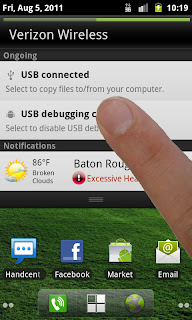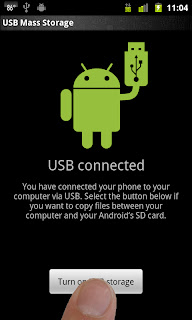Terms for this post:
SMS: Short Messaging Service, also known a text or text messaging
MMS: Multimedia Messaging Service, which is picture or video messages sent in the messaging app
SMS/MMS Thread: A thread is simply a conversation, or collection a of messages between yourself and one other contact.
1. Amy:
Customers/users have media(pictures) being stored to the internal memory vs. the removable SD card.
First thing I would try is educating the user on how to activate "Mass Storage Mode" on their Android, when plugged in to a computer. Which is easily activated by pulling down on the notification bar, and selecting the USB connection, which defaults to "Charge Only", and selecting Mass Storage.


A vast majority of computers have generic drivers for a mass storage device, so no special software or access to the internet is required for this action.
The next option to move the pictures, is to simply send them in an email. Even to the phone's own Gmail account is good enough for this. Try not to send them using picture messaging, or MMS, due to the pictures being reduced in size to fit the requirements of MMS. Emailed pictures maintain their original size and quality, where MMS or picture messaged images are sent at a percentage of their original quality.
In most Android email applications, you can attach multiple files/pictures to a single outgoing email. Easiest way that I have found to do this is by going in to the phone's Gallery or Photos app, and holding you finger on a picture in the group you would like to send. Doing this, the phone will allow you to select multiple pictures at once.
Please take note, the Gmail will only allow you to send approximately 15MB of files per email, where most other email services will only accept emails 10MB or smaller to your inbox. Keep the number of pictures sent with each email to around 5 or 6 for safety reasons.
Please let me know if this doesn't help your situation.
2. Jennifer:
Samsung Gem, or similar lower system memory phone, giving errors about low memory, can't receive incoming message
There are three situations that come to mind concerning this issue, and they all can apply equally.
First, by default Androids DON'T delete your texting/SMS history. Unlike older phones, RAZRs or even basic keyboard phones, which delete any messages after they have 100-200, depending on model, Androids will NOT erase any SMS without you telling it to.
On my personal phone I have Handcent to manage my SMS duties. In one of my earlier posts on installing Handcent, I recommended going in to the original messaging app and disabling notifications, while in there you can make sure thse phone is also set to delete messages after a certain amount. On my personal phone, the settings are 200 SMS and 30 MMS per thread.
I have ran in to a couple phones that didn't have an option for auto delete, which I don't have a spacific app that I recommend to take care of this task (which are available), but do recommend keeping an eye on the size of some of your SMS threads. A known glitch in Android is the inability to delete an SMS thread with over 1,000 messages in the conversation. Both high-end and low-end Androids I've come across this, which, if I come across I will simply wipe the phone and have the customer start from scratch.
Wiping a phone is usually the last thing I would ever do, but it is one situation that calls for it.
Second situation, when the user/owner uses Gmail as their primary email address. I've noticed, and come across a couple discussions about a memory leak in the actual Gmail app itself.
My personal main Gmail inbox usually has around 1500-2000 emails, just in the inbox. After a couple days I would get an error about low system memory, but still see over 100MB free system memory in phone information.
To resolve this memory issue I installed K-9 email handler. After installing K-9, go to the phone's main screen, Setting - Accounts, and turn off Gmail syncing. After turning off syncing, go in to Settings - Applications - Manage Applications and uninstall the Gmail app and all updates.
K-9 supports an IMAP and push connection to Gmail, so it will work just as easy and quick as the Gmail app, but only keeps the last 25 emails cached. Helps email run a lot quicker, and reduces the memory requirement on the phone.
Third, and easiest reason for low memory is too many apps. No, not a single phone is designed to download and run every app available app from the Android Market. Downloading every app that sounds cool, and not uninstalling the ones you'll never use again, will eat up your phone's memory.
There are some apps out there to assist people who need to have EVERY cool app ever released. I use one just to have all the free memory I can, which is App2SD. Every app that is lists can be moved to the SD card, and free up some memory. My dialer replacement, Dialer One is the only app I don't move to the SD, so it is always available to the phone, even right after a reboot. I choose to install Dialer One since my current software doesn't include HTC's Sense interface, and I still wanted the ability to spell a name on the dial pad to call someone. No digging through my contact list of over 800 listings. Also, if you're in to Live Wallpapers, don't put any of those on the SD card, most of the time it will prevent them from loading.
It's the end of a long day, and the first company kickball game. I'm tired and out of questions.
NO TASK KILLERS!!!!
Ask me more, I'm better at describing things here than over the phone.


